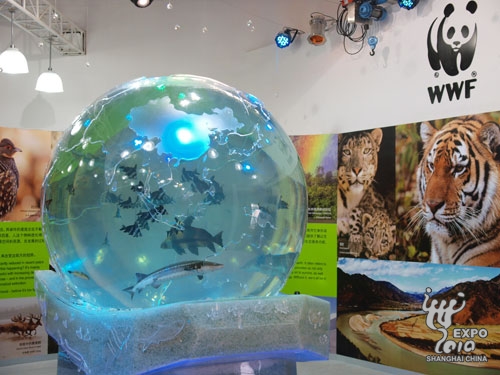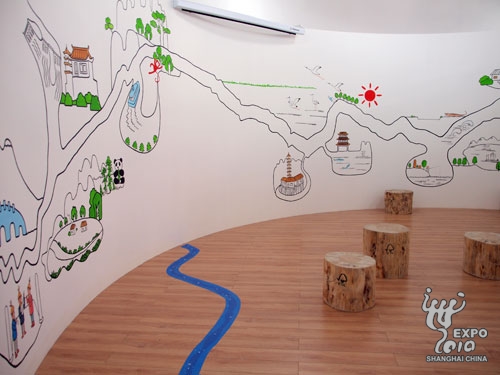Paradise for children
The World Wildlife Fund Pavilion
Chinese sturgeon and more
No doubt about it: Children love animals, big and small, and the World Wildlife Fund Pavilion is a great place for them to learn more about their favorite critters. Here, we'll take a look at just a few of the most interesting features of this pavilion.
Attraction One: Five Chinese sturgeons
The most eye-catching item in the pavilion is a giant water tank in the shape of a ball. Called "The Ball of Life," the tank changes colors, from red to green and is engraved with a map of the world. Inside the tank are five Chinese sturgeons, as well as some other rare and well-known fish; all of the fish are from the Yangtze River and are under state or provincial-level protection.
There are two big holes at the top and bottom sides of the tank. At night, staff feed the fish through the hole on the top; the hole at the bottom is for water circulation. As all of the fish inside are rare species that need special care and protection, the staff members are on duty around the clock. New varieties of fish will be introduced to the tank over the next few weeks.
 |
| The "Ball of Life" at the World Wildlife Fund Pavilion |
Attraction Two: Interesting pictures
Hanging inside the pavilion are pictures depicting environmentally friendly activities: adults riding their bikes to the office, solar panels generating electricity and trash being classified correctly. Other pictures depict environmental degradation; scenes from the oil spill in the Spanish city of Malaga and caged gorillas in Indonesia. From these pictures, pavilion organizers hope that children will realize how fragile our environment is and learn some ways by which we can preserve it.
In addition, a mural painting titled Coexisting With Nature features stories of the harmonious coexistence between man and nature. The painting shows the Hani terraces of southwestern Yunnan Province as well as the Dujiangyan Dam, built in 756 B.C.
 |
| A child's drawing, The Yangtze River |
Attraction Three: Flash animation
There are also five short Flash-animated movies on display, each telling a story about how we can conserve resources and protect our environment. One story informs visitors that a standard bathtub contains 100 liters of water; if people take too many baths, the Yangtze River might decrease in depth and seawater will flow back into the river. This will spoil the habitat of the Dazha crab found in the area; this crab is a well-known delicacy.
Attraction Four: Environmental commitment
The pavilion also features a video camera where visitors can record their wishes and ideas about environmental protection. The camera can take pictures, which can be shown on a large screen at the pavilion's entrance. Visitors can also download their pictures from the WWF's official website.
Attraction Five: Televiewing giant pandas
Ten giant pandas can be seen live on the pavilion's large screen. The pandas came from Sichuan just before the Shanghai World Expo opened, and are now living in the Shanghai Zoo until October. This live broadcast featuring the pandas and the zoo is very popular among child visitors.
 0
0 







Go to Forum >>0 Comments